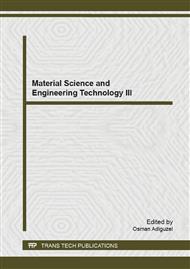p.3
p.8
p.15
p.20
p.28
p.32
p.36
p.40
Degradation Mechanism of Glass/Polyester Composite Exposure to Acidic and Alkaline Solutions at Room Temperature
Abstract:
The aim of this work is the studyof the degradation mechanism of a glass fiber/unsaturated polyester (UP) composite immersed inacidic(H2SO4)and alkaline(NaOH)solutionslike establishing a relation between the chemical and the mechanical behaviors of this material. The gravimetric analyses showed a pseudo fickianbehavior for the samples immersed in H2SO4 and mass losses with a pseudo-stage of saturation as from 64 hours of immersion for the samples immersed in NaOH.The Fourier transform infrared analysis (FT-IR)of the UP resin revealed the presence of chemical degradation phenomenon (hydrolysis).Microscopic observations (SEM) confirmed the fibres/matrix interfacesdegradation. The effect of these degradations has been reflected one the mechanical properties of the materials.
Info:
Periodical:
Pages:
20-27
Citation:
Online since:
April 2015
Authors:
Keywords:
Price:
Сopyright:
© 2015 Trans Tech Publications Ltd. All Rights Reserved
Share:
Citation:


